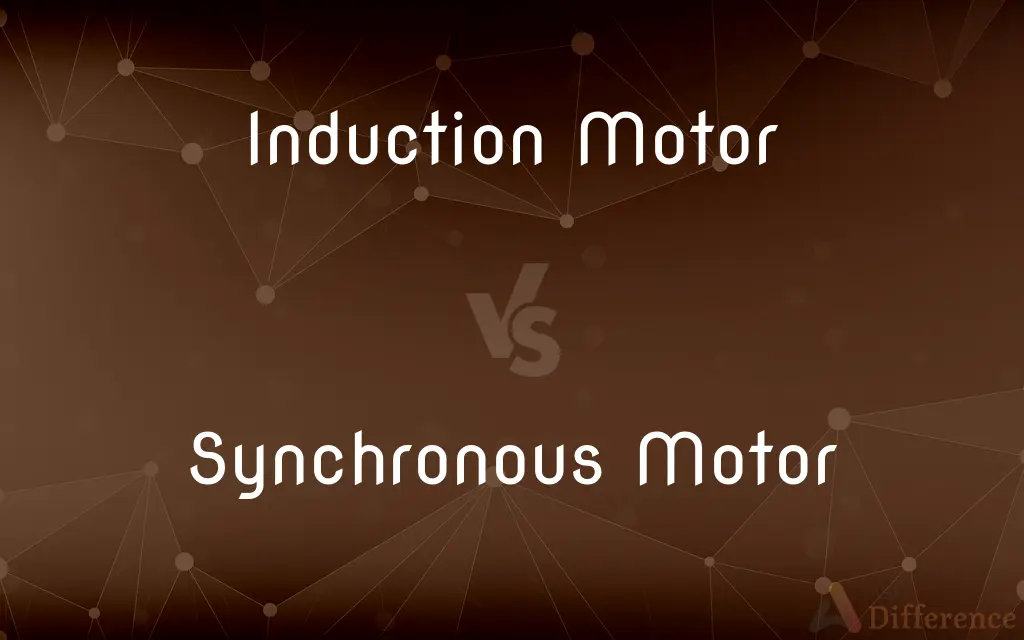Induction Motor vs. Synchronous Motor — What's the Difference?
By Fiza Rafique & Urooj Arif — Published on March 7, 2024
Induction motors operate asynchronously with a simple, robust design, ideal for general-purpose use. Synchronous motors, in contrast, operate at a constant speed, matching the supply frequency, perfect for applications requiring precise speed control.

Difference Between Induction Motor and Synchronous Motor
Table of Contents
ADVERTISEMENT
Key Differences
Induction motors, also known as asynchronous motors, operate by inducing an electromagnetic field in the rotor without direct electrical connection to it, which makes them simpler and more rugged. Their speed varies with the load and they are widely used due to their simplicity, reliability, and low cost. Synchronous motors, however, maintain a constant speed determined by the supply frequency and the number of poles in the motor, making them suitable for applications where a constant speed is needed, regardless of load variations.
The construction of an induction motor is generally less complex than that of a synchronous motor. Induction motors do not require an external DC power source for the rotor, unlike synchronous motors, which need either a permanent magnet or an external DC source to power the rotor windings. This distinction makes induction motors easier to maintain and less expensive to manufacture.
Efficiency and performance between the two types of motors also differ. Induction motors typically have a lower initial cost and are preferred for applications that do not require precise speed control, such as fans, pumps, and general machinery. Synchronous motors, while more expensive, offer higher efficiency and are preferred in applications requiring precise speed control and power factor correction capabilities, such as in large industrial fans, compressors, and pumps where speed needs to be synchronized with the electrical grid frequency.
The operational speed of an induction motor is not constant and decreases as the load increases due to "slip," which is the difference between the speed of the rotating magnetic field and the rotor. Synchronous motors have no slip since their rotor speed is locked to the frequency of the supply current, which is beneficial for applications where speed consistency is critical.
Choosing between an induction motor and a synchronous motor depends on the specific requirements of the application, including speed control, efficiency, cost, and maintenance. Induction motors are often favored for their simplicity and reliability in a wide range of applications, while synchronous motors are chosen for their precision and efficiency in specific scenarios.
ADVERTISEMENT
Comparison Chart
Operating Principle
Operates asynchronously, speed varies with load
Operates at constant speed, synchronized with supply frequency
Construction Complexity
Simpler, no external DC source for rotor
More complex, requires DC source or permanent magnets for rotor
Cost
Lower initial cost
Higher initial cost due to complex construction
Efficiency
Generally lower efficiency
Higher efficiency, especially at constant speeds
Speed Control
Speed varies with load; less precise control
Precise speed control; speed does not vary with load
Applications
General machinery, fans, pumps
Applications requiring precise speed or power factor correction
Maintenance
Lower maintenance requirements
Higher maintenance due to external DC source or rotor windings
Slip
Present, speed decreases with load
No slip, speed is constant regardless of load
Compare with Definitions
Induction Motor
A robust motor design operating asynchronously with the power supply.
Induction motors power most household washing machines.
Synchronous Motor
Operates at a constant speed, exactly matching the supply frequency.
Synchronous motors are used in clocks for precise timekeeping.
Induction Motor
Generally offers lower efficiency but sufficient for broad applications.
Despite lower efficiency, induction motors are widely used in industrial applications for their reliability.
Synchronous Motor
Requires an external DC source or permanent magnets for operation.
Large industrial synchronous motors often use an external DC supply for the rotor.
Induction Motor
Speed varies under load conditions, making it versatile.
Induction motors are used in conveyor belts for their adaptability to different speeds.
Synchronous Motor
Offers precise speed control, ideal for specific applications.
Synchronous motors are favored in compressors where constant speed is crucial.
Induction Motor
Features simple construction without the need for external DC sources.
The simplicity of induction motors makes them ideal for fans and pumps.
Synchronous Motor
No slip between the supply frequency and the motor speed.
Synchronous motors maintain constant speed in paper mills for uniform paper production.
Induction Motor
Preferred for applications not requiring precise speed control.
Induction motors are commonly found in general-purpose machinery due to their robustness.
Synchronous Motor
Higher initial cost but provides higher efficiency and power factor correction.
Despite the higher cost, synchronous motors are efficient in long-term industrial use.
Common Curiosities
Can synchronous motors operate at variable speeds?
While inherently designed to operate at a constant speed, synchronous motors can run at variable speeds when paired with variable frequency drives (VFDs), although this setup is more complex and costly.
Why would one choose a synchronous motor over an induction motor?
Synchronous motors are chosen for applications requiring precise speed control, high efficiency, and power factor correction, such as in precision machinery and where speed must be synchronized with the electrical grid.
Where are induction motors typically used?
Induction motors are widely used in general-purpose applications such as household appliances, fans, pumps, and conveyors due to their simplicity and robustness.
What is "slip" in an induction motor?
Slip is the difference between the speed of the rotating magnetic field (synchronous speed) and the actual speed of the rotor, which allows the motor to produce torque.
What maintenance considerations differ between the two motor types?
Induction motors have lower maintenance requirements due to their simpler construction, while synchronous motors may require more attention due to their external DC power source and rotor windings.
What is the main difference between induction and synchronous motors?
The main difference is that induction motors operate asynchronously with variable speed under load, while synchronous motors maintain a constant speed aligned with the supply frequency.
Can both motor types be used in industrial applications?
Yes, both types are used in industrial applications, but the choice depends on the specific needs of the application, such as the requirement for speed control, efficiency, and cost considerations.
Is one motor type better than the other?
Neither motor type is inherently better; the choice depends on the application requirements, including speed control, efficiency, initial cost, and maintenance.
Are synchronous motors more expensive than induction motors?
Yes, synchronous motors are generally more expensive due to their complex construction, including the need for a DC power source for the rotor or the use of permanent magnets.
How does the efficiency of induction motors compare to synchronous motors?
Synchronous motors are typically more efficient than induction motors, especially in applications where a constant speed is maintained.
Share Your Discovery

Previous Comparison
DPBS vs. PBS
Next Comparison
FTP vs. SFTPAuthor Spotlight
Written by
Fiza RafiqueFiza Rafique is a skilled content writer at AskDifference.com, where she meticulously refines and enhances written pieces. Drawing from her vast editorial expertise, Fiza ensures clarity, accuracy, and precision in every article. Passionate about language, she continually seeks to elevate the quality of content for readers worldwide.
Co-written by
Urooj ArifUrooj is a skilled content writer at Ask Difference, known for her exceptional ability to simplify complex topics into engaging and informative content. With a passion for research and a flair for clear, concise writing, she consistently delivers articles that resonate with our diverse audience.













































